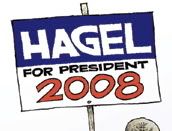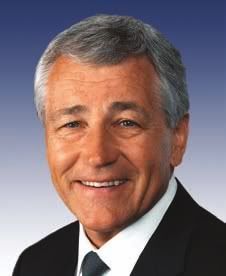
In the late winter/ early spring of 2007 a slow grumble began to grow in the United States. It began, perhaps, in the minds of the politically elite, found its way into the media and finally into the minds of the citizens of our nation. It was the noise of pre-presidential election debate. Across the United States murmurs began to arise about possible presidential candidates and about which qualities could be attributed to each of these people. One candidate discussed during this period was Nebraska’s own Senator Chuck Hagel. Up until this point Hagel was best known as a 2 term Republican senator of Nebraska, avid opposer of the war in Iraq, Vietnam veteran, entrepreneur and native Nebraskan. While in congressional office he became a prominent political figure and gained the reputation of a “liberal republican”, a reputation that many thought would gain him bipartisan favor if he sought to run for the presidency in 2008. Although he never official announced his candidacy, a lot people believed that it was only a matter of time before this Nebraska senator jumped into the presidential race. Many were in such great anticipation for his assumed announcement that they jumped to begin work to ensure he had a foundation of supporters for his candidacy. However, as time went along he, according to some critics, missed his window of media attentive opportunity, and of finance collecting to announce his candidacy. The cartoon presented was published in August of 2007 and it presents arguments stressing just how far Chuck Hagel was from being able to consider a legitimate bid for the White House.
This picture, first published by Leavenworth Street, embodies several different strategies through which it seeks to convey its point. The picture deals with Chuck Hagel’s thought of running for the presidency, which is stated very directly through the picket sign he is holding and by the badge he is wearing. Perhaps the first thing a person notices when viewing the photo is the picketing sign Hagel is holding. When the methods used to advertise a political candidate is considered, generally the image the mind comes up with is much grander than the sign Hagel appears to be waiving on his own behalf. The sign appears to be homemade, lacking
 any special detail or slogan, and tacked onto a wooden stick. This method of campaigning is actually quite humorous when we compare it to the mudslinging television ads, and detailed banners and fliers we usually see revolving around a presidential election. Also the badge Hagel wears appears to be rudimentary, bare skeleton of a mere idea that Hagel could be considered as a candidate for office. The illustration seeks to convey, through the lack of any surrounding images other than the central figure itself, that even if Chuck Hagel sought a presidential bid it would probably not gain enough notice to be in a position from which he could effectively run a campaign. One of the strategies we see used over and over again in this argument is the cause and effect strategy. The image conveys the point that if Chuck Hagel chose to run for the presidency it would result in him not being able to put together an efficient campaign due to his lack of resources and due to the late start he would be getting off the blocks. The image also classifies Senator Hagel as a less than note worthy presidential candidate, through the “army of one” comment, by stressing his lack of resources necessary to run a campaign, such as press attention, organization and planning, and by this point time as well. It is interesting also to take an in depth look at how the image shows the argument that Chuck Hagel’s chances of seriously, and successfully seeking a presidential bid are slim to none. The image is structured to embody a mock campaign rally, which might be used by a candidate’s supporters to seek further support for the candidate. The ironic part, the part that makes a statement, about this image is that Chuck Hagel is starkly alone in the image, apparently without any fellow supporters/ or ralliers, which continues to stress all the things Hagel lacks to build a candidacy. Also the lone statement at the bottom emphasizes just how obscure the author feels the validity of citizens assuming Hagel to be a strong candidate for the 2008 election to be. This image also shows this lack of support to Hagle’s campaign by not picturing anyone around him, which effectively to emphasizes to the viewer just how alone he would be in his campaign efforts if he had decided to run for office. The animation done to the figure of Hagel within the cartoon also can be viewed as a statement about the whispered candidacy of Nebraska’s senator. The fact that H
any special detail or slogan, and tacked onto a wooden stick. This method of campaigning is actually quite humorous when we compare it to the mudslinging television ads, and detailed banners and fliers we usually see revolving around a presidential election. Also the badge Hagel wears appears to be rudimentary, bare skeleton of a mere idea that Hagel could be considered as a candidate for office. The illustration seeks to convey, through the lack of any surrounding images other than the central figure itself, that even if Chuck Hagel sought a presidential bid it would probably not gain enough notice to be in a position from which he could effectively run a campaign. One of the strategies we see used over and over again in this argument is the cause and effect strategy. The image conveys the point that if Chuck Hagel chose to run for the presidency it would result in him not being able to put together an efficient campaign due to his lack of resources and due to the late start he would be getting off the blocks. The image also classifies Senator Hagel as a less than note worthy presidential candidate, through the “army of one” comment, by stressing his lack of resources necessary to run a campaign, such as press attention, organization and planning, and by this point time as well. It is interesting also to take an in depth look at how the image shows the argument that Chuck Hagel’s chances of seriously, and successfully seeking a presidential bid are slim to none. The image is structured to embody a mock campaign rally, which might be used by a candidate’s supporters to seek further support for the candidate. The ironic part, the part that makes a statement, about this image is that Chuck Hagel is starkly alone in the image, apparently without any fellow supporters/ or ralliers, which continues to stress all the things Hagel lacks to build a candidacy. Also the lone statement at the bottom emphasizes just how obscure the author feels the validity of citizens assuming Hagel to be a strong candidate for the 2008 election to be. This image also shows this lack of support to Hagle’s campaign by not picturing anyone around him, which effectively to emphasizes to the viewer just how alone he would be in his campaign efforts if he had decided to run for office. The animation done to the figure of Hagel within the cartoon also can be viewed as a statement about the whispered candidacy of Nebraska’s senator. The fact that H agel is wearing a war helmet speaks to the fact that, had the campaign been managed differently, he might have been able to run an effective campaign for the oval office. The helmet symbolizes Hagel’s resistance to the Iraq war, which is a central issue in the upcoming election. The illusion to this fact shows that Hagel was not in want for a platform to run on, or for the ability to be the next president, but rather that, through mishandling of his pre-campaign work, he fell behind on putting together the necessary pieces of shaping a campaign, such as a wealth of campaign money or an early shotgun
agel is wearing a war helmet speaks to the fact that, had the campaign been managed differently, he might have been able to run an effective campaign for the oval office. The helmet symbolizes Hagel’s resistance to the Iraq war, which is a central issue in the upcoming election. The illusion to this fact shows that Hagel was not in want for a platform to run on, or for the ability to be the next president, but rather that, through mishandling of his pre-campaign work, he fell behind on putting together the necessary pieces of shaping a campaign, such as a wealth of campaign money or an early shotgun into headline news to gain exposure. Also, as the image is analyzed we notice that the Hagel’s head appears to be crushed in. The animation of the head is far from being comparable to the actual structure of Hagel’s face. The image of the squeezed face is another analogy to how Hagel was seeking to jumpstart his campaign when he was squeezed for time beyond that necessary to build a practical campaign.
into headline news to gain exposure. Also, as the image is analyzed we notice that the Hagel’s head appears to be crushed in. The animation of the head is far from being comparable to the actual structure of Hagel’s face. The image of the squeezed face is another analogy to how Hagel was seeking to jumpstart his campaign when he was squeezed for time beyond that necessary to build a practical campaign.When we apply rhetorical appeals to this argument we see that it appeals mainly to Logos and Pathos. We see the image’s appeal to logos in that it can be seen as a rational argument. It is rational to assume that Chuck Hagel’s lack of support, and mishandled pre-campaign activity played a large role in him not announcing a bid for the White House. The pathos of the argument comes from the appeal of this argument to the reader’s sense of humor. The figure
 itself is comical and also there is dry humor and sarcasm implied through the use of the US Army’s tagline about standing alone. When the army uses the slogan “an army of one” it brings about the feeling that one person can make a difference, however, in the image we look at it seems to be more of a slapstick joke that someone may assume that Hagel, as one lone man, could actually work his way into a presidential bid.
itself is comical and also there is dry humor and sarcasm implied through the use of the US Army’s tagline about standing alone. When the army uses the slogan “an army of one” it brings about the feeling that one person can make a difference, however, in the image we look at it seems to be more of a slapstick joke that someone may assume that Hagel, as one lone man, could actually work his way into a presidential bid.So is did Chuck Hagel have enough support and resources to make a bid for the Republican ticket? The author of this photography certainly believes that his idea of running is joke-worthy. Also it is apparent, from the fact that he didn’t announce his candidacy, that some of the claims the photos held true not only in the mind of the author, but also in the mind of Chuck Hagel himself.
No comments:
Post a Comment